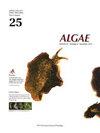Based on morphology and molecular data, Palisada rigida comb. nov. and Laurencia decussata comb. et stat. nov. (Rhodophyta, Rhodomelaceae) are proposed
IF 2.4
3区 生物学
Q1 MARINE & FRESHWATER BIOLOGY
引用次数: 1
Abstract
Inspecting herbaria collections of Laurencia rigida highlighted frequent misidentifications between L. rigida and L.heteroclada f. decussata, two poorly studied taxa from Australia. Recent collections of DNA material, including from topotypematerial, allowed for re-examination of these two taxa using molecular techniques. Detailed morphological andmolecular analyses based on two markers (rbcL and COI-5P) strongly supported these two taxa as being distinct fromeach other and requiring nomenclatural changes. Comprehensive morphological analyses highlighted features useful foraccurate identifications. Interestingly, L. rigida was found to belong to the genus Palisada with evidence from both themorphology and molecular data. Therefore, this study proposed recognizing L. rigida as Palisada rigida comb. nov. Moleculardata for L. heteroclada f. decussata on the other hand supported its separation from L. heteroclada, with too greata molecular distance to be considered a variety. Morphological characters that best separated P. rigida from L. decussataincluded seven characters; number of pericentral cells per vegetative axial segment, the presence of secondary pit connections,the presence of lenticular thickenings, tetrasporangia alignment, the presence of corps en cerise, holdfast morphology,and overall plant shape. Morphologically, L. heteroclada f. decussata was also separated from L. heteroclada,particularly by the following characteristics; ultimate branchlets morphologies, lower order branch lengths, primary axisand holdfast morphologies. Therefore, it was proposed that L. heteroclada f. decussata is recognized at a species level asL. decussata comb. et stat. nov.基于形态学和分子数据,刚玉梳。11月和劳伦西亚·德库萨塔·科姆。et stat. 11 . (Rhodophyta, Rhodomelaceae)被提出
检查硬枝Laurencia rigida的植物标本集,突出了硬枝L.rigida和叉叶L.heterolada之间的频繁误认,这两个来自澳大利亚的分类群研究不足。最近收集的DNA材料,包括拓扑型材料,允许使用分子技术对这两个分类群进行重新检查。基于两个标记(rbcL和COI-5P)的详细形态学和分子分析有力地支持这两个分类群彼此不同,需要命名法的改变。全面的形态学分析突出了有助于准确识别的特征。有趣的是,从形态学和分子数据上都有证据表明,L.rigida属于Palisada属。因此,本研究提出将刚果木犀认定为刚果木梳。nov。D.decussata的分子数据另一方面支持它与L.heterolada的分离,因为它的分子距离太大,不能被认为是一个变种。最能分离硬脊藻和叉叶藻的形态特征包括7个性状;每个营养轴段的中央周围细胞的数量,次生凹坑连接的存在,透镜状增厚的存在,四孢囊排列,团状内切酶的存在,固着形态和整体植株形状。在形态上,盾叶L.heterolada f.decussata也与盾叶L.Heterolada分离,特别是通过以下特征;最终的小枝形态,较低的分枝长度,主轴和保持形态。因此,有人提出在物种水平上将C.heterolada f.decussata识别为L。交叉梳。et stat.nov。
本文章由计算机程序翻译,如有差异,请以英文原文为准。
求助全文
约1分钟内获得全文
求助全文
来源期刊

Algae
PLANT SCIENCES-
CiteScore
5.10
自引率
25.00%
发文量
18
期刊介绍:
ALGAE is published by the Korean Society of Phycology and provides prompt publication of original works on phycology. ALGAE publishes articles on all aspects of phylogenetics and taxonomy, ecology and population biology, physiology and biochemistry, cell and molecular biology, and biotechnology and applied phycology. Checklists or equivalent manu-scripts may be considered for publication only if they contribute original information on taxonomy (e.g., new combinations), ecology or biogeography of more than just local relevance. Contributions may take the form of Original Research Articles, Research Notes, Review Articles and Book Reviews.
 求助内容:
求助内容: 应助结果提醒方式:
应助结果提醒方式:


